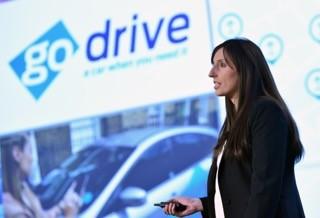
Google, Ford, Apple, Amazon, Tesla and General Motors are just some of the companies on the verge of introducing zero-emissions smart mobility technologies. These innovations will seamlessly integrate customer transportation needs with the optimal mobility choice -- think: Amazon Prime for vehicle and urban transportation choices, delivery and payment.
Zero-emissions smart mobility will enable a quantum leap in human productivity, quality of life and environmental sustainability. It will deliver lower consumer costs, increased safety, more convenience, enhanced productivity and cleaner air. Early adopting cities will win competitive economic advantages. The cities that do not adopt this technology may end up being the 21st century’s version of the Industrial-Age mill town.
Imagine
Imagine this weekend scenario. Friday is your wedding anniversary. A bright red electric convertible arrives at your home. You drive your spouse along a scenic highway as you enjoy the sunset and the fun of accelerating at the speed of electrons. You leave the red convertible outside the restaurant where you are celebrating your anniversary. It then moves on to its next customer or a parking space. After a romantic dinner with cocktails and a bottle of wine, you walk out of the restaurant and get into an autonomous driving car that safely drives you home and then departs.
On Saturday morning, a full-size hybrid pickup truck arrives to take the family, and your boat, to the lake and then back home. A small electric van arrives on Monday morning to take you -- and neighbors who live within a mile of your home -- to the light-rail station, just in time to catch the 7:15 train to your city-center office.
You paid for all of these vehicles through a Ford, Amazon or Apple app on your phone. The digital receipt has a running year-to-date savings total earned from not owning a vehicle. You smile because this service is so much easier, more productive and enjoyable than owning a car and a truck, even if it didn’t save a dime.
Now stop imaging, and recognize that this is not a concept in a Power Point presentation. Ford is piloting a similar mobility-as-a-service program in London.
Ford’s London pilot program
I interviewed Alicia Agius, the project lead for Ford's GoDrive program in London. GoDrive is a pilot project that is testing consumer response to integrated technology solutions designed to enhance urban mobility. I was blown away by how close Ford is to commercializing mobility as a service on a global scale.
GoDrive brands itself as a “car when you need it.” It provides on-demand access to a car from 25 locations conveniently located across London. The consumer experience begins by downloading the Ford GoDrive app on a smartphone. Working through the app, a customer picks a vehicle, unlocks it and turns it on. There is no reservation process. There is no upfront membership fee to use the service. You pay by the minute. If you use a car for 15 minutes, then you pay for just 15 minutes of use and not for an hour or a day of use.
It is a one-way service. No need to bring the car back to the point where you picked it up. You drive to your desired location that should have a Ford GoDrive facility within walking distance. You park the car, and the Ford app bills your account. The considerable urban stress of finding a parking space is eliminated. The service is cheaper than Uber, ZipCar-like rentals or cab services, and it is easier to access.
Introducing electric cars as part of the GoDrive program
Another mission of the GoDrive program is to introduce consumers to electric cars. Half of the cars in the service are gasoline fueled. The other half are electric. Here is what Ford saw:
- 44 percent of first-time customers choose electric
- 74 percent choose electric after their first experience with electric
- 61 percent of customers are using electric vehicles
What Ford learned is that mobility-as-a-service eliminates the perceived customer barriers to using electric cars. Electric cars offered through mobility-as-a-service eliminates the consumer concern over the potential higher initial purchase cost of electric cars. The issues of range anxiety and recharging access are also eliminated. The typical drive is about 40 miles, and that is at least half of a fully charged electric car’s range. The GoDrive program handles recharging cars back to full charge.
Ford surveyed its customers to gain their reactions to driving an electric car. Some of the comments were:
- "Quite cool to be driving an electric."
- "Easy to drive and I would certainly use it again."
- "I took an electric car as I wanted to relax and they are quiet."
Agius reports that GoDrive customers found electric cars to be “nippy, quiet and lovely to drive.”
Why mobility as a service is a 21st-century mega-trend
The future of the auto industry, and your city, is in the triple integration of zero-emissions smart vehicles, the Internet of Things, and mobility-as-a-service programs to deliver these solutions:
- Congestion reduction
- Increased human productivity
- Reduced, or eliminated, transportation-sourced air pollution
How soon could that be? In 2007 Steve Jobs introduced the iPhone. In less than 10 years, we now have digital mobility as a service. It can happen that fast in the Information Age!
Image credits: 1) Eric Bennett 2) Ford

Bill Roth is a cleantech business pioneer having led teams that developed the first hydrogen fueled Prius and a utility scale, non-thermal solar power plant. Using his CEO and senior officer experiences, Roth has coached hundreds of CEOs and business owners on how to develop and implement projects that win customers and cut costs while reducing environmental impacts. As a professional economist, Roth has written numerous books including his best selling The Secret Green Sauce (available on Amazon) that profiles proven sustainable best practices in pricing, marketing and operations. His most recent book, The Boomer Generation Diet (available on Amazon) profiles his humorous personal story on how he used sustainable best practices to lose 40 pounds and still enjoy Happy Hour!














